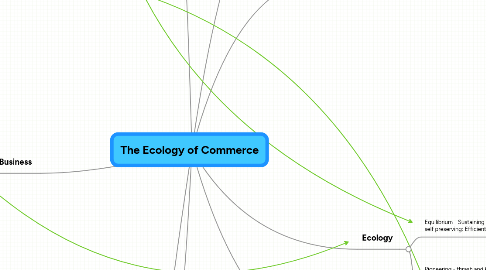
1. Business
1.1. Grow without increased demand of resources
1.2. Add value to the economy
1.3. Make a positive contribution to society
1.4. Management of toxic business is inefficient
1.5. "The seeds of corporate dysfunction reside in the nature of business (today), not in size of enterprise."
1.6. Intelligent Product System - Braungart & Englefried
1.6.1. Consumables
1.6.2. Products of service
1.6.3. Unsaleables
1.6.4. Productivity down : employment and profits up
1.7. The Economics of Welfare - A.C. Pigou (82)
1.7.1. Cost/Price integration
1.7.2. Implementation of "sin" taxes
1.8. Competition should not be between wasting the environment Vs. Saving, but between those that can do the best job in restoring.
1.8.1. "It shouldn't be so hard to do the right thing."
1.9. Growth Vs. Development
1.10. Medicine
1.10.1. Allopathic Medicine
1.10.2. Preventive Medicine
1.11. Energy
1.11.1. Conservation/Management
1.11.2. Industry
1.12. Guidelines for Sustainable Business
1.12.1. Go Local - Replace non local
1.12.2. Take responsibility for effects on Natural World
1.12.3. No exotic sources of capital for Growth/Development
1.12.4. Engage in production that is human, worthy, dignified, and intrinsically satisfying
1.12.5. Create objects of durability and long term utility whose use/disposition will not harm
1.12.6. Change consumers to customers through education
1.13. Market for Efficiency
2. Things to Research
2.1. Department of Neighborhoods
2.2. Dynamic Governance
2.3. Industrial Ecology
2.4. Kalundborg - Novo Nordisk
2.5. Economies of Scale
2.6. Menominee
3. 3 Principles
3.1. Waste = Food - The elimination of waste from industrial production
3.2. Carbon Economy -> Hydrogen/Sunshine economy - revering incentives surrounding production and consumption of energy - Amory Lovin's "Soft Path"
3.3. Systems of Feedback/Accountability that support restorative behavior
4. New Idea
5. Ecology
5.1. Equilibrium - Sustaining and self preserving: Efficient
5.1.1. Soil/Agriculture
5.1.2. Sustainable yield > temporary increase
5.1.3. Restorative Economy: Practices vs Principles
5.2. Pioneering - thrash and burn = high/fast production
5.2.1. Demand > Sustainable supply?
6. Waste
6.1. The resource War
6.1.1. depletion of resources
6.2. By definition: Uneconomical
6.3. Cradle to grave vs cradle to cradle
7. Systems of Survival - Jane Jacobs
7.1. Guardian
7.1.1. Governance
7.1.1.1. Tradition
7.1.1.2. Hierarchy and Loyalty
7.1.1.3. Preservation of resources
7.2. Commerce
7.2.1. Trade
7.2.1.1. Compete
7.2.1.2. Be efficient
7.2.1.3. Innovation
7.3. Examples of Conflict between the two systems
7.3.1. Government interfering with business/trade - Government insurance for investment businesses (giving prive institutions every incentive to choose the riskiest investments)
7.3.2. Business trying to assume the role of guardianship but ultimately causes more harm in an effort to drive their finances
7.3.3. Government responds to businesses failure in the ecosystem by attempting to establish more regulations creating a bureaucratic monster, wasting money and strangling business.
7.3.4. Often appears as a two party system
7.3.4.1. Liberals
7.3.4.1.1. At their best: propose controls and regulations on business that promote sustainability.
7.3.4.1.2. At their worst: Attempt to unite Guardian/Commercial, producing socialist enterprise with marginal efficiency.
7.3.4.2. Conservatives
7.3.4.2.1. At their best: Free market, human enterprise, creativity, and innovation
7.3.4.2.2. At their worst: Ignoring the values of health and habitat: The unification of Commercial/Guardian where everything is controlled by a commercial entity seeking to further their own agenda.

